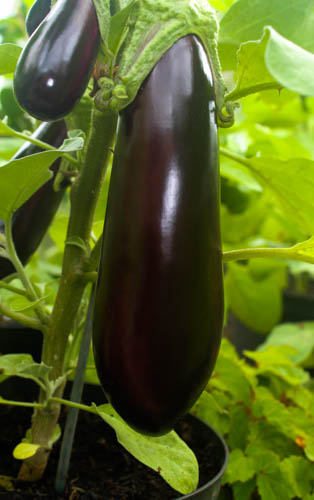
Blossom End Rot, where the end of tomatoes becomes circular, black and flattened, occurs in peppers and aubergines, squashes and watermelons but is most often seen in tomatoes. It is caused by lack of calcium in the fruits. Plants in soil, growing bags and potting composts rarely lack a supply of calcium but what they often lack an adequate flow of water within the plant for it to reach the outer parts. It doesn’t get much further away from the roots than the fruits, particularly near the top of the plant. Plants with limited rooting space in pots and growing bags are most likely to have problems, along with those growing in acidic conditions; plants in borders with a larger root run are less likely to suffer. Adding fertiliser to dry soil or compost can also cause problems, because the concentration of nutrients in the soil water restricts moisture uptake by the plant; high air humidity can also cause water uptake problems.
To reduce the chance of Blossom End Rot, keep the greenhouse well ventilated and the soil consistently moist, throughout the growing season, watering twice a day if needed. It is particularly important when using growing bags as the compost is very difficult to moisten once it dries out. Mulching, automatic watering systems, larger pots (up to 37.5cm in diameter), or growing in border soil are all helpful, especially when frequent watering is not always possible. Liquid fertiliser must only be applied to moist soil, according to the manufacturer’s instructions. You can still eat tomatoes with Blossom End Rot, just slice off the damaged tissue.
Continue sowing ‘cut and come again’ crops in pots, like mixed herbs; mixed salads can be started under the greenhouse benching then moved outdoors. Sow chicory and chard for leaves, chervil, coriander, parsley and rocket, lettuce, salad onion, spinach and spring cabbage for crops later in the year.
Check aubergines, sweet peppers, cucumber, melon and chilli’s for red spider mite and whitefly. Use organic sprays containing plant oils or extracts, fatty acids or plant invigorator and maintain high humidity to control red spider mite and natural pyrethrum, fatty acids or plant oil sprays to control whitefly. They are very short persistence and require regular reapplication to keep whitefly in check. Biological controls can also be used. (All are available from the internet from websites like https://www.pippagreenwood.com/ )
Keep an eye on watering and ventilation, it is particularly important to do this before temperatures start to rise. Stand watering cans in the greenhouse for 24 hours so the water warms before use. Fruiting crops like cucumbers, aubergines and tomatoes need a constant supply of water. Feed weekly, with high potash tomato fertiliser, and ‘damp down’ the floor to increase humidity or use a hand sprayer to mist among cucumber leaves.
Harvest crops regularly and while you eat the delicious produce, it’s time to be thankful that gardening provides such wonderful rewards for your labour.
Happy gardening, Matt.


